by Paul Gilster | Oct 10, 2018 | Asteroid and Comet Deflection |
To me, the image below is emblematic of space exploration. We look out at vistas that have never before been seen by human eye, contextualized by the banks of equipment that connect us to our probes on distant worlds. The fact that we can then sling these images globally through the Internet, opening them up to anyone with a computer at hand, gives them additional weight. Through such technologies we may eventually recover what we used to take for granted in the days of the Moon race, a sense of global participation and engagement.
We’re looking at the MASCOT Control Centre at the German Aerospace Center (Deutsches Zentrum für Luft- und Raumfahrt; DLR) in Cologne, where the MASCOT lander was followed through its separation from the Japanese Hayabusa2 probe on October 3, its landing on asteroid Ryugu, and the end of the mission, some 17 hours later.
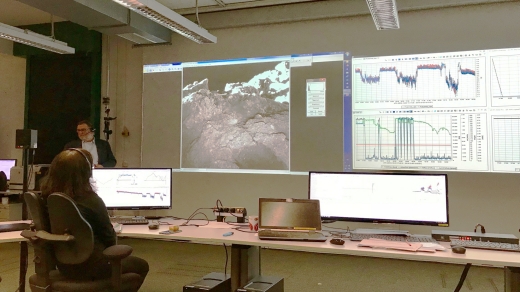
Image: In the foreground is MASCOT project manager Tra-Mi Ho from the DLR Institute of Space Systems in Bremen at the MASCOT Control Centre of the DLR Microgravity User Support Centre in Cologne. In the background is Ralf Jaumann, scientific director of MASCOT, presenting some of the 120 images taken with the DLR camera MASCAM. Credit: DLR.
As scientists from Japan, Germany and France looked on, MASCOT (Mobile Asteroid Surface Scout) successfully acquired data about the surface of the asteroid at several locations and safely returned its data to Hayabusa2 before its battery became depleted. A full 17 hours of battery life allowed an extra hour of operations, data collection, image acquisition and movement to various surface locations.
MASCOT is a mobile device, capable of using its swing-arm to reposition itself as needed. Attitude changes can keep the top antenna directed upward while the spectroscopic microscope faces downwards, a fact controllers put to good use. Says MASCOT operations manager Christian Krause (DLR):
“After a first automated reorientation hop, it ended up in an unfavourable position. With another manually commanded hopping manoeuvre, we were able to place MASCOT in another favourable position thanks to the very precisely controlled swing arm.”
MASCOT moved several meters to its early measuring points, with a longer move at the last as controllers took advantage of the remaining battery life. Three asteroid days and two asteroid nights, with a day-night cycle lasting 7 hours and 36 minutes, covered the lander’s operations.
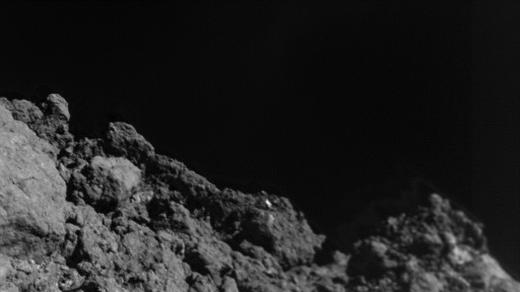
Image: The images acquired with the MASCAM camera on the MASCOT lander during the descent show an extremely rugged surface covered with numerous angular rocks. Ryugu, a four-and-a-half billion year-old C-type asteroid has shown the scientists something they had not expected, even though more than a dozen asteroids have been explored up close by space probes. On this close-up, there are no areas covered with dust — the regolith that results from the fragmentation of rocks due to exposure to micrometeorite impacts and high-energy cosmic particles over billions of years. The image from the rotating MASCOT lander was taken at a height of about 10 to 20 meters. Credit: MASCOT/DLR/JAXA.
The dark surface of Ryugu reflects about 2.5 percent of incoming starlight, so that in the image below, the area shown is as dark as asphalt. According to DLR, the details of the terrain can be captured because of the photosensitive semiconductor elements of the 1000 by 1000 pixel CMOS (complementary metal-oxide semiconductor) camera sensor, which can enhance low light signals and produce usable image data.
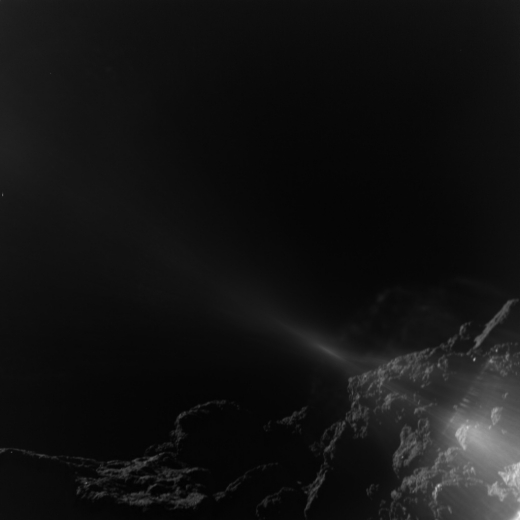
Image: DLR’s MASCAM camera took 20 images during MASCOT’s 20-minute fall to Ryugu, following its separation from Hayabusa2, which took place at 51 meters above the asteroid’s surface. This image shows the landscape near the first touchdown location on Ryugu from a height of about 25 to 10 meters. Light reflections on the frame structure of the camera body scatter into the field of vision of the MASCAM (bottom right) as a result of the backlit light of the Sun shining on Ryugu. Credit: MASCOT/DLR/JAXA.
We now collect data and go about evaluating the results of MASCOT’s foray. The small lander had a short life but it seems to have delivered on every expectation. As Hayabusa2 operations continue at Ryugu, we’ll learn a great deal about the early history of the Solar System and the composition of near-Earth asteroids like these, all of which we’ll be able to weigh against what we find at asteroid Bennu when the OSIRIS-REx mission reaches its target in December.
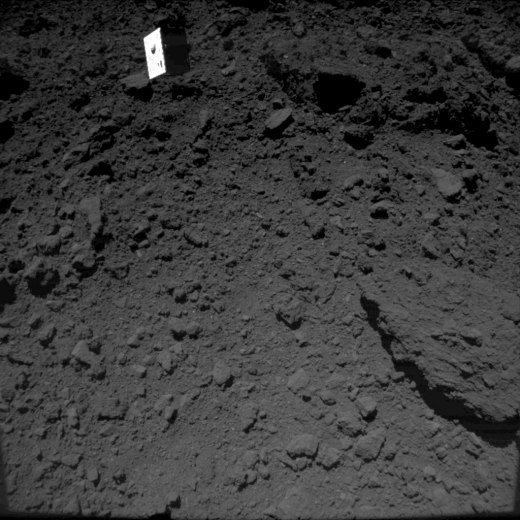
Image: MASCOT as photographed by the ONC-W2 immediately after separation. MASCOT was captured on three consecutively shot images, with image capture times between 10:57:54 JST – 10:58:14 JST on October 3. Since separation time itself was at 10:57:20 JST, this image was captured immediately after separation. The ONC-W2 is a camera attached to the side of the spacecraft and is shooting diagonally downward from Hayabusa2. This gives an image showing MASCOT descending with the surface of Ryugu in the background. Credit: JAXA, University of Tokyo, Kochi University, Rikkyo University, Nagoya University, Chiba Institute of Technology, Meiji University, University of Aizu, AIST.
Bear in mind that the the 50th annual meeting of the Division for Planetary Sciences (DPS) of the American Astronomical Society (AAS) is coming up in Knoxville in late October. Among the press conferences scheduled are one covering Hayabusa2 developments and another the latest from New Horizons. The coming weeks will be a busy time for Solar System exploration.

by Paul Gilster | Oct 3, 2018 | Exoplanetary Science |
8,000 light years from Earth in the constellation Cygnus, the star designated Kepler 1625 may be harboring a planet with a moon. The planet, Kepler 1625b, is a gas giant several times the mass of Jupiter. What David Kipping (Columbia University) and graduate student Alex Teachey have found is compelling though not definitive evidence of a moon orbiting the confirmed planet.
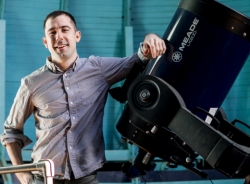
If we do indeed have a moon here, and upcoming work should be able to resolve the question, we are dealing, at least in part, with the intriguing scenario many scientists (and science fiction writers) have speculated about. Although a gas giant, Kepler 1625b orbits close to or within the habitable zone of its star. A large, rocky moon around it could be a venue for life, but the moon posited for this planet doesn’t qualify. It’s quite large — roughly the size of Neptune — and like its putative parent, a gaseous body. If we can confirm the first exomoon, we’ll have made a major advance, but the quest for habitable exomoons does not begin around Kepler 1625b.
Image: Columbia’s Alex Teachey, lead author of the paper on the detection of a potential exomoon. Credit: Columbia University.
None of this should take away from the importance of the detection, for exploring moons around exoplanets will doubtless teach us a great deal about how such moons form. Unlike the Earth-Moon system, or the Pluto/Charon binary in our own Solar System, Kepler-1625b’s candidate moon would not have formed through a collision between two rocky bodies early in the history of planetary development. We’d like to learn how it got there, if indeed it is there. Far larger than any Solar System moon, it is estimated to be but 1.5% of its companion’s mass.

The methods David Kipping has long espoused through the Hunt for Exomoons with Kepler (HEK) project have come to fruition here. Working with data on 284 planets identified through the Kepler mission, each of them with orbital periods greater than 30 days, Kipping and Teachey found interesting anomalies at Kepler-1625b, where Kepler had recorded three transits. The lightcurves produced by these transits across the face of the star as seen from the spacecraft showed deviations that demanded explanation.
Image: Exomoon hunter David Kipping. Credit: Columbia University.
Their interest heightened, the researchers requested and were awarded 40 hours of time on the Hubble Space Telescope, whose larger aperture could produce data four times more precise than that available from Kepler. On October 28 and 29 of 2017, the scientists took data through 26 Hubble orbits. Examining the lightcurve of a 19-hour long transit of Kepler-1625b, they noted a second, much smaller decrease in the star’s light some 3.5 hours later.
Kipping refers to it as being consistent with “…a moon trailing the planet like a dog following its owner on a leash,” but adds that the Hubble observation window closed before the complete transit of the candidate moon could be measured. The paper addresses this second dip:
The most compelling piece of evidence for an exomoon would be an exomoon transit, in addition to the observed TTV [transit timing variation]. If Kepler-1625b’s early transit were indeed due to an exomoon, then we should expect the moon to transit late on the opposite side of the barycenter. The previously mentioned existence of an apparent flux decrease toward the end of our observations is therefore where we would expect it to be under this hypothesis. Although we have established that this dip is most likely astrophysical, we have yet to discuss its significance or its compatibility with a self-consistent moon model.
In and of itself, this is exciting information, but as noted above, we also learn in this morning’s paper in Science Advances that transit timing variations are apparent here. The planet itself began its transit 77.8 minutes earlier than predicted. One way to account for this is by the pull of a moon on the planet, resulting in their both orbiting a common center of gravity and thus throwing the transit calculation (based on an unaccompanied planet) off. What Kipping and Teachey will need to eliminate is the possibility that a second planet, yet undetected, could have caused the timing variation. There is thus far no evidence from Kepler of such a planet.
“A companion moon is the simplest and most natural explanation for the second dip in the light curve and the orbit-timing deviation,” said lead author Teachey. “It was a shocking moment to see that light curve, my heart started beating a little faster and I just kept looking at that signature. But we knew our job was to keep a level head testing every conceivable way in which the data could be tricking us until we were left with no other explanation.”
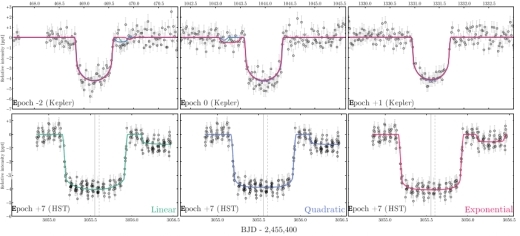
Image: This is Figure 4 from the paper. Caption: Moon solutions. The three transits in Kepler (top) and the October 2017 transit observed with HST (bottom) for the three trend model solutions. The three colored lines show the corresponding trend model solutions for model M, our favored transit model. The shape of the HST transit differs from that of the Kepler transits owing to limb darkening differences between the bandpasses. Credit: David Kipping, Alex Teachey.
One problem with exomoon hunting is that the ideal candidate planets are those in wide orbits, but this makes for long periods between transits. Even so, the number of large planets in orbits farther from their star than 1 AU is growing, and such worlds should be useful targets for the upcoming James Webb Space Telescope. Although we still have to confirm Kepler-1625b’s moon, such a confirmation could prove only the beginning of a growing exomoon census.
We’ll know more as we make more detections, but for now, I think Kipping and Teachey’s caution is commendable. Noting that confirmation will involve long scrutiny, observations and skepticism from within the community, they point out:
…it is difficult to assign a precise probability to the reality of Kepler-1625b-i. Formally, the preference for the moon model over the planet-only model is very high, with a Bayes factor exceeding 400,000. On the other hand, this is a complicated and involved analysis where a minor effect unaccounted for, or an anomalous artifact, could potentially change our interpretation. In short, it is the unknown unknowns that we cannot quantify. These reservations exist because this would be a first-of-its-kind detection — the first exomoon.
A final thought: The paper points out that the original Kepler data that flagged Kepler-1625b as interesting in exomoon terms were actually stronger than the Kepler data Kipping and Teachey added into the mix for this work. They are now working with the most recent release, which had to be revisited for all factors that could affect the analysis. It turns out that this most recent release “only modestly favors that hypothesis when treated in isolation.” The HST data make the strongest case in strengthening the case for an exomoon. The authors believe that this shows the need to pursue similar Kepler planets for exomoons with HST and other facilities, even in cases where the Kepler data themselves do not show a large exomoon-like signature.
The paper is Teachey & Kipping, “Evidence for a large exomoon orbiting Kepler-1625b,” Science Advances 3 October 2016 (complete citation when I have it).

by Paul Gilster | Sep 24, 2018 | Asteroid and Comet Deflection |
That small spacecraft can become game-changers, our topic last Friday, is nowhere more evident than in the success of Rover 1A and 1B, diminutive robot explorers that separated from the Hayabusa2 spacecraft at 0406 UTC on September 21 and landed soon after. Their target, the asteroid Ryugu, will be the site of detailed investigation not only by these two rovers, but also by two other landers, the German-built Mobile Asteroid Surface Scout (MASCOT) and Rover 2, the first of which is to begin operations early in October. Congratulations to JAXA, Japan’s space agency, for these early successes delivered by its Hayabusa2 mission.
Surface operations will be interesting indeed. Both rovers were released at an altitude of 55 meters above the surface, their successful deployment marking an advance over the original Hayabusa mission, which was unable to land its rover on the asteroid Itokawa in 2005. Assuming all goes well, the mission should gather three different samples of surface material for return to Earth in 2020. The third sample collection is to take advantage of Hayabusa2’s Small Carry-on Impactor (SCI), which will create a crater to retrieve subsurface material.
Why Ryugu? The object is a carbonaceous asteroid that has likely changed little since the Solar System’s early days, rich in organic material and offering us insight into the kind of objects that would have struck the Earth in the era when life’s raw materials, along with water, could have been delivered. It has also proven, as the JAXA team knew it would, a difficult landing site, with an uneven distribution of mass that produces variations in the gravitational pull over the surface.
On that score, it’s interesting to note that the Hayabusa2 controllers are sharing data with NASA’s OSIRIS-REx mission to asteroid Bennu. Likewise a sample return effort, OSIRIS-REx will face the same gravitational issues inherent in such small, irregular objects, which can be ameliorated by producing maps of each asteroid’s gravity. The three-dimensional models produced for the Dawn spacecraft at Ceres are the kind of software tools that will help both mission teams understand their targets better and ensure successful operations on the surface.
But back to Rover 1A and 1B, which have landed successfully and are both taking photographs and sending data, the first time we have landed and moved a probe autonomously on an asteroid surface. Although the first image was blurred because of the rover’s spin, it did display the receding Hayabusa spacecraft and the bright swath of the asteroid just below. Here’s JAXA’s mission tweet of that first image.
Says Tetsuo Yoshimitsu, who leads the MINERVA-II1 rover team:
Although I was disappointed with the blurred image that first came from the rover, it was good to be able to capture this shot as it was recorded by the rover as the Hayabusa2 spacecraft is shown. Moreover, with the image taken during the hop on the asteroid surface, I was able to confirm the effectiveness of this movement mechanism on the small celestial body and see the result of many years of research.
The ‘hop’ Yoshimitsu refers to is a reference to the means of locomotion the rovers will use on the surface. Remember that these vehicles are no more than 18 centimeters wide and 7 centimeters high, weighing on the order of 1 kilogram. In Ryugu’s light gravity, the rovers will make small jumps across the surface, a motion carefully constrained so as not to reach the object’s escape velocity. Below is the first Rover-1A image taken during a hop.

Image: Captured by Rover-1A on September 22 at around 11:44 JST. Color image captured while moving (during a hop) on the surface of Ryugu. The left-half of the image is the asteroid surface. The bright white region is due to sunlight. Credit: JAXA.
And have a look at an image taken during landing operations before Rover-1B reached the surface. Here the asteroid terrain is clearly defined.

Image: Captured by Rover-1B on September 21 at around 13:07 JST. This color image was taken immediately after separation from the spacecraft. The surface of Ryugu is in the lower right. The coloured blur in the top left is due to the reflection of sunlight when the image was taken. Credit: JAXA.
Yuichi Tsuda is Hayabusa2 project manager:
I cannot find words to express how happy I am that we were able to realize mobile exploration on the surface of an asteroid. I am proud that Hayabusa2 was able to contribute to the creation of this technology for a new method of space exploration by surface movement on small bodies.
I would say Tsuda’s pride in his team and his hardware is more than justified. As we go forward with surface operations, let me commend Elizabeth Tasker’s fine work in spreading JAXA news in English. Even as JAXA offers live updates from Hayabusa2 in English and the official Hayabusa2 site offers its own coverage, Tasker, a British astrophysicist working at JAXA, has provided useful mission backgrounders like this one, as well as running the English-language Hayabusa2 Twitter account @haya2e_jaxa, and keeping up with her own Twitter account @girlandkat. There will be no shortage of Ryugu news in days ahead.

by Paul Gilster | Sep 21, 2018 | Missions |
The image below intrigues me. It’s the first image of the Earth and the Moon together taken from a CubeSat, one of a pair of such tiny spacecraft NASA has despatched to Mars as part of a mission called MarCO (Mars Cube One), which will work in conjunction with the InSight lander. Taken on May 9, the photo was part of the process of testing the CubeSat’s high-gain antenna. But to me it’s a reminder of how far miniaturized technologies continue to advance.
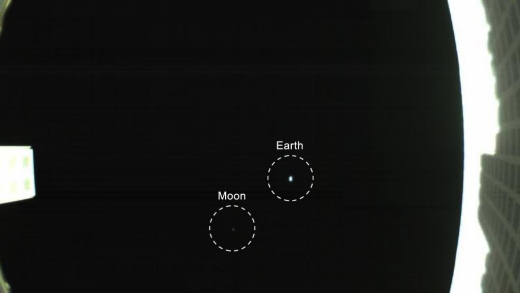
Image: The first image captured by one of NASA’s Mars Cube One (MarCO) CubeSats. The image, which shows both the CubeSat’s unfolded high-gain antenna at right and the Earth and its moon in the center, was acquired by MarCO-B on May 9. Credit: NASA/JPL-Caltech.
As of this morning, we are 66 days away from InSight’s landing on Mars, at a distance of 65 million kilometers from Earth and 16 million kilometers to Mars. I don’t usually focus on Mars and lunar missions because this site’s specialty is deep space, which for our purposes means Jupiter and beyond, and of course the overall theme here is interstellar. But experimental technologies that bring us greater performance from very small payloads are certainly relevant.
Anything we can do to shrink payload size pays off as we look at ever more distant targets, and the cruise velocities and propellant needed to reach them. And CubeSats are a way of exploring small payloads. The standard 10×10×11 cm basic CubeSat is a ‘one unit’ (1U) CubeSat, but larger platforms of 6U and 12U allow more complex missions. With fixed satellite body dimensions, the CubeSat format creates a highly modular and integrated system.
What we have with the two MarCO spacecraft is the application of what had been a low-Earth orbit satellite technology to a planetary mission, with a useful goal. Trailing InSight by thousands of kilometers, they’ve already demonstrated their ability to operate in the interplanetary environment. At Mars, the intention is for them to relay data on InSight’s landing, a job consigned to Mars orbiters, but one this mission may show CubeSats are able to perform.
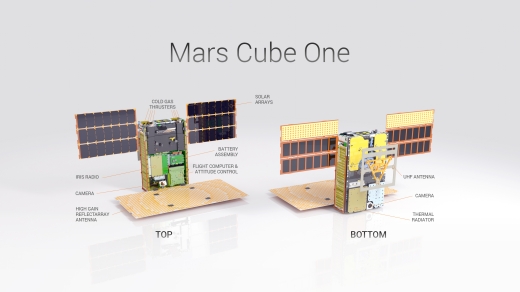
Image: Illustration of one of the twin MarCO spacecraft with some key components labeled. Front cover is left out to show some internal components. Antennas and solar arrays are in deployed configuration. Credit: NASA/JPL-Caltech.
Each of the MarCOs has its own high-gain antenna and the necessary radio equipment for data relay, with propulsion systems that have already made two steering maneuvers enroute. No one would claim the diminutive space travelers are as complex as conventional interplanetary craft, but I can see two goals here, the first of which leverages the ‘traditional’ CubeSat role of acting as low-cost entry-level ways to reach orbit.
“Our hope is that MarCO could help democratize deep space,” said Jakob Van Zyl, director of the Solar System Exploration Directorate at NASA’s Jet Propulsion Laboratory in Pasadena, California. “The technology is cheap enough that you could envision countries entering space that weren’t players in the past. Even universities could do this.”
Fair enough, as we’ve learned how satellites can be ‘piggybacked’ to open up access to space, lowering launch costs even as the cost of the CubeSats offers opportunities for inexpensive missions. Moreover, the fact that CubeSats can be built with standardized parts and systems, with key components provided by commercial partners, underscores their efficiency.
But let’s move beyond today’s current CubeSat. If we can build these craft strong enough to handle relay operations from Mars, we can contemplate future CubeSats capable of a wider range of science return and consider propulsion technologies like solar sails for ‘swarm’ missions to targets beyond Mars. Of particular interest is coupling CubeSats with solar sails for propulsion. Remember, for example, The Planetary Society’s LightSail-1, launched in 2015, which demonstrated sail deployment despite a series of major software glitches.
LightSail-2 is designed to demonstrate controlled solar sailing in the CubeSat format, with a sail of 32 square meters. A key goal of this mission is to raise the orbit apogee after sail deployment at 720 kilometers. I should also mention LightSail-3, which could take this technology out to the L1 Lagrangian point, where it would remain to monitor geomagnetic activity on the Sun.
NASA’s own future plans for CubeSat work take in BioSentinel, which would take living yeast (S. cerevisiae) into space to study DNA lesions caused by energetic particles, with operations expected to last 18 months at distances well beyond low Earth orbit. The NEA (Near-Earth Asteroid) Scout mission would take a CubeSat/sail to a small asteroid, exploring its rotational properties, spectral class, regional morphology and regolith, while Lunar Flashlight would achieve lunar orbit to study ice deposits on the Moon for the use of future explorers.
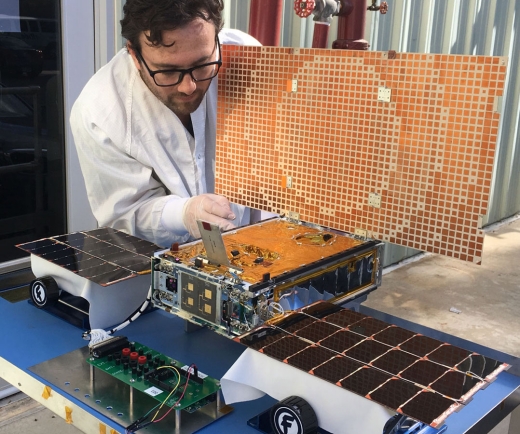
Image: Engineer Joel Steinkraus uses sunlight to test the solar arrays on one of the Mars Cube One (MarCO) spacecraft. Credit: NASA/JPL-Caltech.
I might likewise mention such European Space Agency efforts as GOMX-3, a CubeSat mission exploring the telecommunications capabilities of such craft. GOMX-3 was deployed from the International Space Station in October of 2015 and operated for a year before re-entering the atmosphere.
The list of upcoming missions under ESA’s In-Orbit Demonstration is extensive (you can see it here), and it’s noteworthy that the agency inserts at the top of its list of potential applications the fact that CubeSats can serve “As a driver for drastic miniaturisation of systems, ‘systems-on-chips’, and totally new approach to packaging and integration, multi-functional structures, embedded propulsion.”
So we can keep an eye on the MarCOs as a harbinger of CubeSat operations to come. All three of the future NASA CubeSat missions I’ve mentioned are designed to be launched as secondary payloads on a future Space Launch System (SLS) mission. But however we get such missions into space, they point toward further exploration of small payloads, a parameter space Breakthrough Starshot is pushing to the max in its plans for a centimeter-sized, gram-scale payload to be driven by laser propulsion at 20 percent of lightspeed to another star.

by Paul Gilster | Sep 13, 2018 | Outer Solar System |
Given that we’ve been talking lately about collisions and water-delivering impacts in the early days of the Solar System, it’s a natural enough segue to today’s work from the Southwest Research Institute (SwRI) on how the planets themselves may have moved about in that era. We also need to talk about the upcoming Lucy mission, which targets two interesting bodies: Patroclus and Menoetius. Both are approximately 112 kilometers wide, comprising a large binary among the Trojan asteroids, which move in leading and trailing orbits around Jupiter.

Image: Jupiter’s extensive Trojan asteroids, divided into ‘Trojans’ and ‘Greeks’ in a nod to Homer, but all Trojans nonetheless. Credit: “InnerSolarSystem-en” by Mdf at English Wikipedia – Transferred from en.wikipedia to Commons. Licensed under Public Domain via Commons.
What David Nesvorny and team have done in their recent paper is to look at migration of Solar System planets, with evidence they believe can be pulled from the Patroclus-Menoetius binary Trojan. What a cataclysmic time this must have been, as both Uranus and Neptune were pushed much further from the Sun, where they would have encountered the objects we see in today’s Kuiper Belt. The Trojans tell at least part of the tale. Says Nesvorny:
“The Trojans were likely captured during a dramatic period of dynamic instability when a skirmish between the Solar System’s giant planets — Jupiter, Saturn, Uranus and Neptune — occurred, Many small bodies of this primordial Kuiper Belt were scattered inwards, and a few of those became trapped as Trojan asteroids.”
Nesvorny has already examined the period of planetary migration in a 2012 statistical study analyzing the early Solar System in terms of four, five and six giant planets, deducing the likelihood that Jupiter’s encounters with a Neptune-class planet caused Jupiter to move inward (perhaps a fraction of an AU) even as Neptune migrated outward. Earlier work has seen these events as being associated with the Late Heavy Bombardment, 4.1 to 3.8 billion years ago. The new paper argues for a much earlier period of migration, with the Patroclus-Menoetius binary forming in a once massive planetesimal disk beyond Neptune.
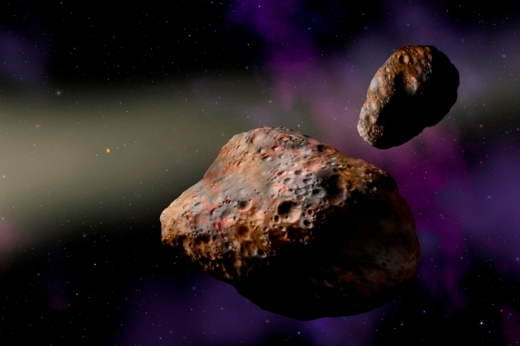
Image: SwRI scientist studied the binary asteroid Patroclus-Menoetius, shown in this artist’s conception, to determine that a shake-up of the giant planets likely happened early in the solar system’s history, within the first 100 million years. Credit: W.M. Keck Observatory/Lynette Cook.
The Lucy mission to study Patroclus-Menoetius comes out of SwRI, with Harold Levison as principal investigator, and is part of the broader investigation into the development of the Solar System. Nesvorny’s work draws on recent work on how small bodies like this binary emerged, with indications that the early Solar System was a place where binary formation was common. Co-author William Bottke at SwRI points to binaries in today’s Kuiper Belt and contrasts their presence with the relatively few that now exist within the orbit of Neptune. What do we make of the difference, and how can we use it to put Patroclus-Menoetius in its proper context?
The researchers think the very existence of the binary Trojan offers information about the chronology of planetary migration. The longer the period of instability was delayed, the more likely that small body binaries in the primordial Solar disk would have been disrupted by collisions, affecting how many binaries would be captured in the population of Trojans. The evidence, then, points to early instability rather than a delay of hundreds of millions of years.
The Late Heavy Bombardment would have ended approximately 700 million years after the dispersal of the protosolar nebula, referenced in the paper as t0, but Nesvorny’s paper argues for planetary migration starting at the time of that dispersal. From the paper:
The outer planetesimal disk at 20-30 au, in which the P-M binary formed, is thought to have been massive (total estimated mass Mdisk ? 20 M?, where M? ? 6 × 1027 g is the Earth mass), as inferred from planetary migration/instability simulations, slow migration of Neptune required to explain the inclination distribution of TNOs [Trans-Neptunian Objects], and the capture probability of JTs [Jupiter Trojans]. The massive disk was subject to intense collisional grinding by impacts between planetesimals. The survival of the P-M binary in such a hostile environment is an important constraint on the disk lifetime, tdisk, defined as the time interval between t0 and the start of Neptune’s migration.
Using simulations within a previously developed collision code, the authors show the sensitivity of the Patroclus-Menoetius binary’s survival to the age of the disk. Just a snippet of this discussion:
Assuming a 100% initial binary fraction, and adopting the 72% dynamical survival probability computed previously, we find that having one P-M binary among the 25 largest JTs with D > 100 km would be a < 0.002 probability event if tdisk ? 400 Myr. The long-lived disks can therefore be ruled out at the 99.8% confidence level.
Because simulations of the survival of Patroclus-Menoetius indicate that the planetesimal disk had to have been dispersed by migrating planets within ? 100 Myr of the dispersal of the protosolar nebula, there is found to be no linkage between planet migration and the Late Heavy Bombardment.
As I mentioned, Harold Levison, who is a co-author on this work, is also the principal investigator of the Lucy mission, which will launch in 2021 and reach the Patroclus-Menoetius binary in 2033. Three imaging and mapping instruments comprising a color imaging and infrared mapping spectrometer, a high-resolution visible imager, and a thermal infrared spectrometer can then be put to work to study the physical properties of these interesting relics.
This is an interesting mission profile, by the way. Lucy will head first for the L4 Trojans, which orbit 60° ahead of Jupiter, where it will study four objects, 3548 Eurybates, 15094 Polymele, 11351 Leucus, and 21900 Orus. A return to Earth and subsequent gravity assist will then take the spacecraft to the L5 Trojan cloud, trailing Jupiter by 60° in its orbit. There, it will study Patroclus-Menoetius, along the way making a flyby of the non-Trojan main belt asteroid 52246 Donaldjohanson, which is named after the discoverer of the famous Lucy hominin fossil. The term ‘hominin’ takes in modern humans but also all extinct human species and ancestors.

Image: A mission emblem for Lucy, which will study primitive asteroids orbiting near Jupiter, showing the team’s interest in the Lucy hominin skeleton as an example of the earliest period of humans, a study the spacecraft is intended to duplicate for the earliest era of Solar System formation. Credit: SwRI.
The paper is Nesvorny et al., “Evidence for very early migration of the Solar System planets from the Patroclus–Menoetius binary Jupiter Trojan,” Nature Astronomy 10 September 2018 (abstract / preprint).


















